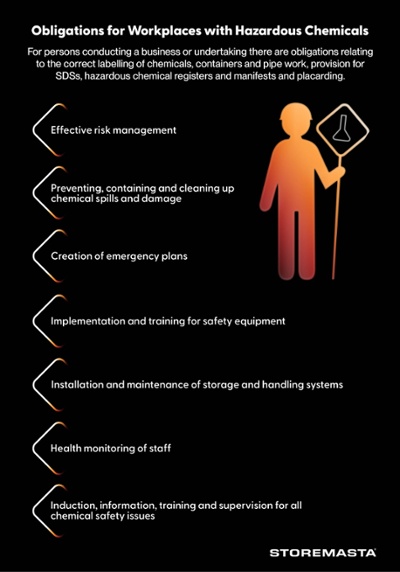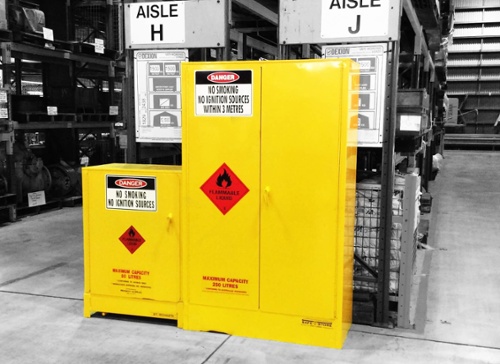When you're operating a worksite that carries any type of dangerous goods, the challenge of maintaining a safe work environment is a key concern. Dangerous goods storage is an essential component of your health and safety obligations, allowing you to keep your hazardous chemicals and dangerous goods in safe storage conditions that minimise risk. In this post, we'll be looking at the dangerous goods storage and handling regulations that are necessary for the protection of your people, property and environment.
Storage and Handling Regulations
As part of your ongoing Work Health and Safety obligations, it is the duty of every employer and employee to ensure that their work environment does not increase the risk of hazardous chemicals or dangerous goods becoming a risk.
Every class of dangerous goods (there are 9 in total) poses specific risks that may not only affect staff, but surrounding residential or commercial buildings, property, vehicles, the local community, and the natural environment.
REMEMBER: Learn more about the 9 Classes of Dangerous Goods by reading our popular blog which details the hazards associated with each of the dangerous goods classes.

There are many everyday products that are classed as dangerous goods, including paints, oils, aerosols and corrosive cleaners.
WHS Laws that apply to your state or territory will give you the essential information about your responsibilities in regard to minimising hazards at your work site.
Some important sections of the WHS Regulations (as adopted by individual jurisdictions) include:
Any person who is conducting a business or undertaking (otherwise referred to as a PCBU) has a primary duty of care to ensure the health and safety of workers while at work in the business or undertaking. This duty of care also extends to any other people who could be affected by the work, such as contractors, visitors or the community.
As part of the primary duty of care, there are a wide range of considerations including:
- provision and maintenance of a safe work environment, safe plant and structures, and safe systems of work
- safe use, handling and storage of substances (including dangerous goods and hazardous chemicals), structures and plant
- implementation of proper information, instruction, training and supervision
- monitoring of the health of staff, as well as conditions at the workplace
Furthermore, if you are considered an officer under WHS laws, you will have an obligation to show a proactive approach to WHS duties. Basically, officers need to exercise due diligence so workplaces can meet WHS duties, including protecting staff and people from harm, and ensuring the business has suitable safe work systems in place.
IMPORTANT: For full details about WHS law and regulation visit Safe Work Australia online or connect with the legislator (such as SafeWork NSW) in your particular state or territory.
Obligations for Workplaces with Hazardous Chemicals
While the WHS Model Regulations apply to all Australian workplaces, there are specific regulations for organisations carrying hazardous chemicals and dangerous goods.
In Chapter 7 Hazardous Chemicals of the Model Work Health and Safety Regulations (2021), there are a wide range of obligations that apply to organisations carrying hazardous chemicals.
Broadly speaking, for PCBUs, there are obligations relating to the:
- correct labelling of chemicals, containers and pipe work
- provision of safety data sheets
- hazardous chemical registers and manifests
- placarding
Hazardous Chemicals Regulations
Controlling the risks associated with hazardous chemicals and dangerous goods, also includes obligations relevant to topics such as:
- ensuring effective risk management
- preventing, containing and cleaning up chemical spills and damage
- creation of emergency plans
- implementation and training for safety equipment
- installation and maintenance of storage and handling systems
- health monitoring of staff
- induction, information, training and supervision for all chemical safety issues
While these obligations are legally binding for any PCBU, it's also important to note that it can be difficult to understand the steps to take to ensure you're meeting your duties under WHS law.

While Safe Work Australia also provides additional information, such as Codes of Practice, which can be helpful for specific workplaces or industries, we recommend familiarising yourself with the Australian Standard that's applicable to each dangerous goods category that you have onsite.
IMPORTANT: For each hazardous chemical product that you have onsite, make sure you read and follow the instructions for handling and storage contained in the safety data sheet (SDS). These SDS must be up-to-date and available for staff to access. We recommend keeping them in a safe place, such as a document holder attached to your chemical cabinet.
Australian Standard
The Australian Standards are a comprehensive range of requirements that are specific to the dangerous goods class of chemicals that you have in your workplace. There are also additional Australian Standards that relate to a range of issues, including the storage and handling of mixed classes of dangerous goods.
If you're storing chemicals or trying to determine the correct storage for your dangerous goods, it's a good idea to refer to the Australian Standard as this will give you clear and detailed guidance. As best practice, the Australian Standard is a valuable resource for any business that works with dangerous goods.
Goods Storage and Handling
While every Standard offers different requirements, some key topics that are detailed may include:
- safe storage for dangerous goods
- storage capacity
- activities within stores
- procedures and systems for handling dangerous goods
- spill prevention and containment
- operational and personnel safety
- personal protective equipment (PPE)
- emergency management
- first aid
- fire protection
- waste storage and disposal
There are many Standards for various chemical types including, but not limited to:
- AS 1940 The storage and handling of flammable and combustible liquids
- AS NZS 5026 The storage and handling of Class 4 dangerous goods
- AS 4326 The storage and handling of oxidizing agents
- AS 2714 The storage and handling of organic peroxides
- AS NZS 4452 The storage and handling of toxic substances
- AS 3780 The storage and handling of corrosive substances
Flammable Liquids Storage Requirements as an Example
To illustrate the level of detail and guidance found within the Australian Standards, let's look at the topic of hazardous chemical spill containment for flammable liquids and combustible liquids (Class 3 dangerous goods).
-1.jpg?width=504&height=336&name=Responding%20to%20a%20flammable%20liquids%20spill%20(1)-1.jpg)
Dangerous goods, such as flammable liquids, must be controlled to reduce the risk of fire, explosion and human harm.
This Standard for flammable and combustible liquids offers a detailed set of requirements for the containment of Class 3 leaks and spills in the work environment.
Such general requirements may include:
- spillage containment compounds must be impervious, to retain and recover spilled chemicals
- spill compound capacity must be at least 100% of the largest package, plus 25% of the storage capacity up to 10 000 L – together with 10% of the storage capacity between 10 000 – 100 000 L, and 5% above 100 000 L
- leaks or spills must be prevented from contaminating soil or entering watercourses or water drainage systems
Furthermore, when storing flammables in a cabinet, requirements specific to spill containment include:
- inner base must form a liquid-tight compound
- the compound must be at least 150 mm deep
- all leakage must be directed into the lower compound
Importance of Compliant Dangerous Goods Storage
While these examples show the depth of detail that is provided to workplaces with flammable liquids, it’s important to note that compliant dangerous goods storage already adheres to these requirements.

Correct storage is necessary to decrease risk.
For example, a Storemasta flammable liquids storage cabinet is constructed in full conformance with the Australian Standard. The Class 3 cabinet features risk controls that not only contain leaks and spills, but also effectively minimise other risks posed by flammable liquids, such as vapour emissions, fire, explosion, and chemical reactions caused by incompatible substances.
Some features include:
- liquid-tight spill containment sump 150 mm deep
- self-closing, close fitting doors that latch at 2 points
- double walled sheet steel construction
- 40mm thermic air barrier to prevent heat radiation
- perforated shelving to assist with vapour movement within cabinet
- compliant dangerous goods signage and hazard signage
By selecting compliant dangerous goods storage for your workplace, you are taking an important first step in making sure that every risk associated with your chemical products is actively controlled by the systems that you put in place. Storage and handling equipment, as well as the inspection and maintenance of your controls, is essential if you want to avoid dangerous workplace incidents — and the associated WHS penalties.
REMEMBER: If you’re not sure that your equipment is compliant, can ask your supplier or manufacturer for confirmation. A certificate of conformance can prove that the dangerous goods storage equipment you’re looking to buy is constructed to meet the Australian Standard.
Implementing Better Dangerous Goods Storage
Now that you have a better understanding of the obligations and requirements relating to dangerous goods storage, why not access our latest eBook? The Ultimate DG Storage Handbook is packed with essential information and practical advice, so you can create a more compliant and safe work environment. In our handbook, we also highlight some simple storage and handling solutions, so that you can ensure your flammable liquids, corrosive substances, toxic substances and other chemicals stay safe. Grab your copy of our Ultimate Handbook today for just $6.99 + GST. It’s a small price to pay for dangerous goods safety.

Living life by the 4 C’s of marketing – communication, coffee, compliance… and more coffee – Leisa Andersen is Storemasta’s Content Marketing Manager. When she’s not writing, you’ll find her enjoying all the good things in life, including shopping, travel and gluten free donuts.
